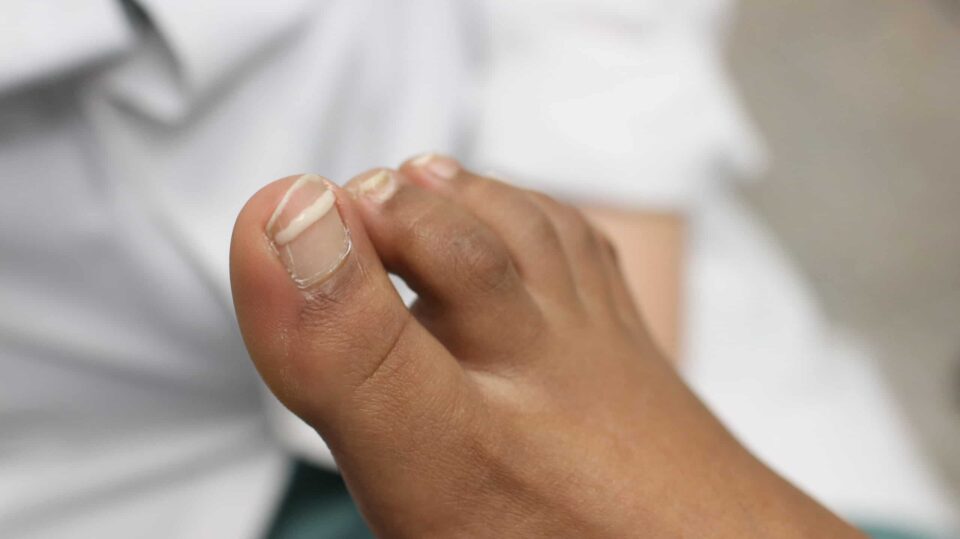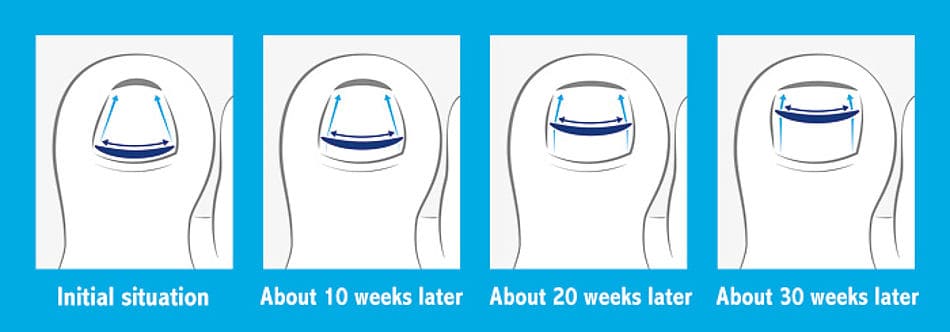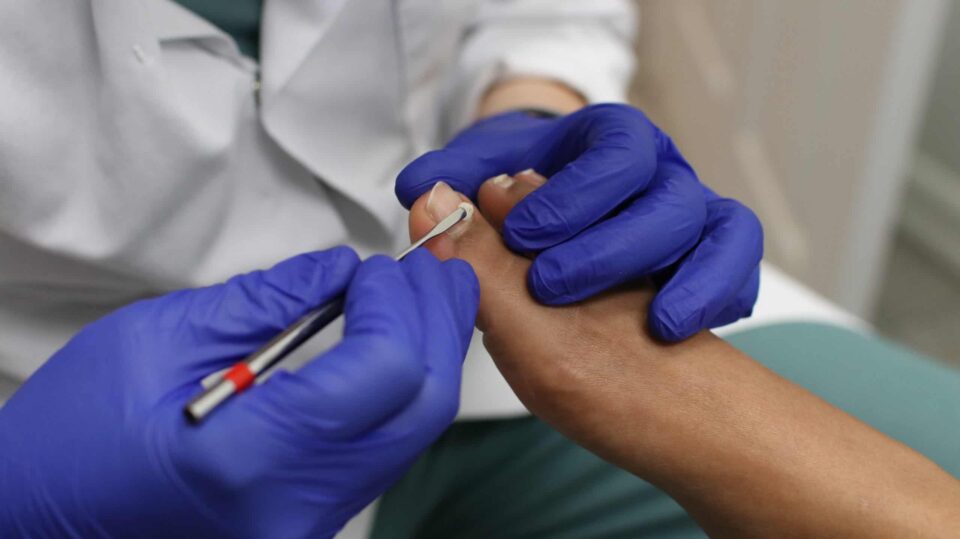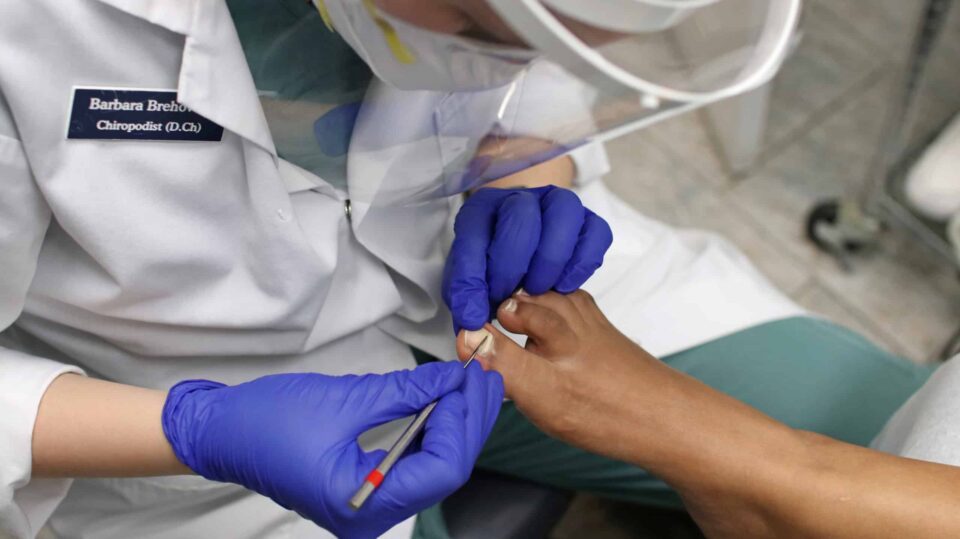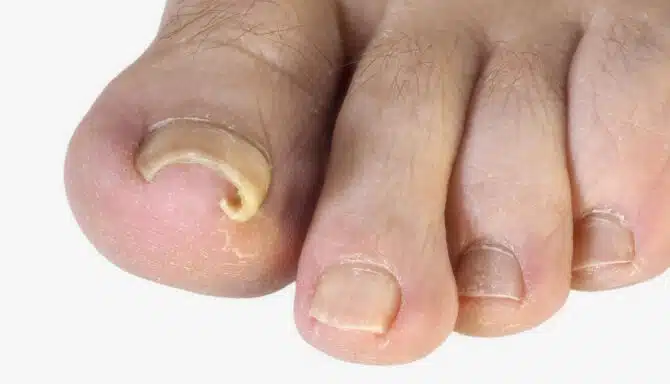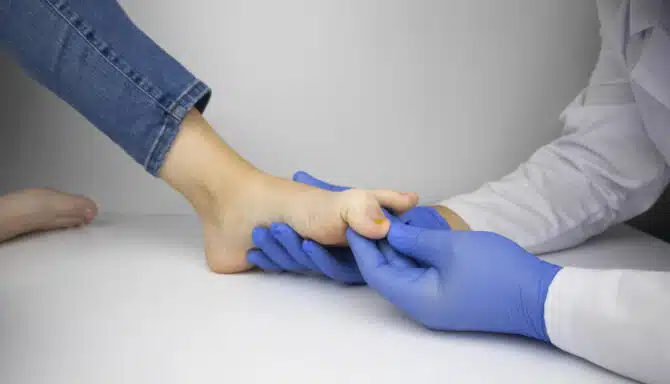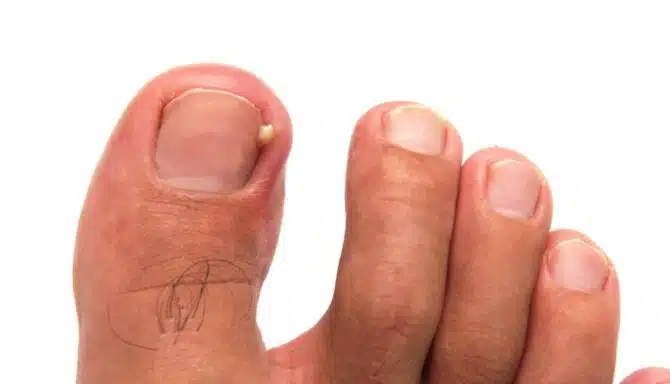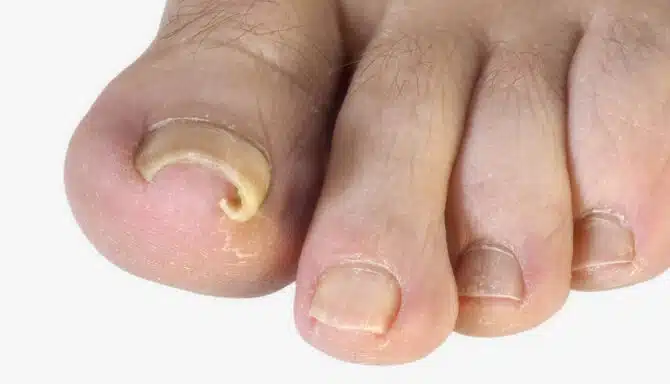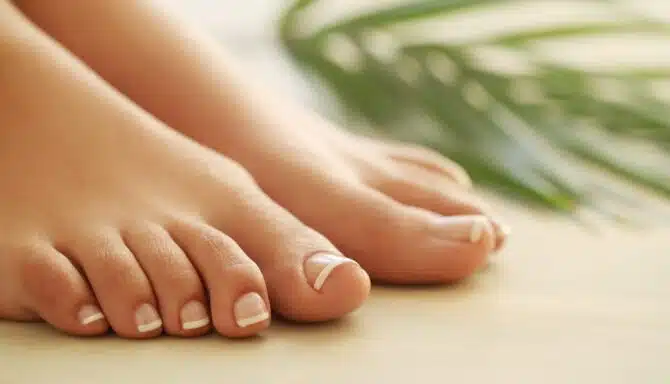April 10, 2025
Curved toenails can indicate various underlying toenail conditions, each with unique causes and additional characteristics. They also don’t always look the same. Toenail curvature issues can range from having a severe Ram’s Horn toenail, accompanied by other symptoms like thickening and discoloration, or small pincer nails that pierce your skin. Let’s learn about curved toenail causes, and most importantly, how a chiropodist or podiatrist can treat curved toenails at a foot clinic so complications don’t arise.
Why Do Toenails Curve?
https://www.youtube.com/shorts/Z6VYvI6CJQs
To understand the best ways of preventing curved toenails, it’s important to learn how healthy toenails grow. They should naturally grow forward in a slightly arched but mostly flat shape, following the contour of the toe. This process begins in the nail matrix, the tissue under the skin at the base of the nail, where specialized cells produce layers of keratin—the protein that makes up the nail.
As new cells form, older cells are pushed outward, harden, and form the visible nail plate. Ideally, the nail grows evenly and straight across, guided by both the shape of the matrix and the direction of mechanical forces applied to the toe, like walking or wearing shoes. The nail bed beneath provides support and helps keep the nail anchored and flat as it grows. A balance between nail thickness, width, and surrounding skin tension is key to maintaining this typical shape.
Toenails start to curve when something disrupts this balance.
Repetitive Trauma from Ill-Fitting Footwear
One common reason is uneven pressure and toe crowding. Tight footwear or repetitive trauma can push the nail’s edges downward or inward over time. That’s why one of the best ways of preventing curved toenails, or virtually all foot conditions for that matter, is purchasing and wearing only shoes that fit properly, allow your toes to splay comfortably, and have ample cushioning, arch support and shock absorption. It’s better to have a small selection of solid, high-quality shoes that support foot health than several pairs of low-quality, poorly designed shoes that cramp your toes.
https://www.youtube.com/shorts/rwNLRZ-MN_M
Genetics
Genetics also play a role in abnormal toenail growth; some people naturally have a more curved nail matrix or a narrower nail bed, both of which can encourage curling. If keratin production is uneven—say, one side of the nail grows faster than the other—the nail can begin to twist or curve as it extends.
Underlying Health Conditions
Inflammatory conditions, infections, poor circulation, or chronic diseases like diabetes can also interfere with normal nail growth by altering cell turnover in the matrix or causing changes to the skin and tissue around the nail. As a result, curved toenails are often not just a cosmetic issue—they can signal deeper structural or health-related concerns.
Curved Toenail Causes
Whether your curled toenails are the result of a sinister condition or simply a genetic growth pattern you’ve inherited, preventing them from getting worse is key. No matter the cause, proper trimming (straight across with simple nail clippers) and wearing shoes that fit well are two of the best things you can do from home to prevent painful complications and live life as comfortably as possible. Below you’ll find some of the most common causes of curved toenails:
Ingrown Toenails (Onychocryptosis)
Ingrown toenails are tricky as they look deceptively mild. But complications, like painful infections, can arise if you ignore them. They develop when the edge of a curved toenail grows into the surrounding skin, causing swelling, redness, and sensitivity. They can look curved, but they also look like a small “extra nail” on the edge of the main nail. It most commonly affects the big toe, and naturally curved toenails (involuted nails) are more likely to become ingrown because their growth pattern is already unusual.
Trimming the nails too short or rounding the edges can also encourage the skin to fold over the nail edge, allowing it to grow inward instead of outward. Repeated pressure or trauma from sports, stubbing the toe, or restrictive footwear (in the toe box, like narrow, pointed high heels) can also disrupt normal growth and set the stage for an ingrown nail to form.
https://www.youtube.com/shorts/B5a3yIgokh8
Pincer Nails (Trumpet Nails)
Classified by podiatrists and chiropodists as “the most painful type of ingrown toenail,” pincer nails, or trumpet nails, occur when the sides of the toenail curve inward toward each other, sometimes so dramatically that the edges look like they want to meet underneath the toe!
This shape creates a pinching effect on the nail bed and surrounding tissue. While some people are born with a naturally curved nail structure that gradually tightens over time, others develop this condition due to external pressures. Long-term use of tight shoes, particularly those with narrow toe boxes, is a major contributing factor. Certain systemic conditions, such as autoimmune disorders or circulatory problems, may also affect the nail matrix and contribute to this unusual curvature. Additionally, aging can play a role, as nail shape and growth patterns tend to change over time.
Onychogryphosis (Ram’s Horn Nails)
View this post on Instagram A post shared by Feet First Clinic (@feetfirstclinic_)
Onychogryphosis is a condition where the toenail becomes dramatically thickened and begins to grow in a distorted, curved, or spiraled shape that resembles a ram’s horn. It often affects the big toe and progresses gradually over time. The nail’s irregular growth is usually the result of uneven cell production in the nail matrix, where one side grows faster than the other.
The most common causes include repetitive trauma (like years of wearing ill-fitted shoes), long-standing fungal infections, or neglect of nail trimming. It’s more frequently seen in older adults or individuals with limited mobility who may struggle with basic foot care. Certain systemic conditions, including psoriasis and vascular disorders, may also interfere with healthy nail growth and lead to this thickened, curved form.
Curved Toenail Pain Relief and Solutions: Nail Disorder Treatment
Toenail curvature can cause pain and nagging discomfort that disrupts your daily life. Remember, the nail should not be growing this way, and it’s up to you to take the first step towards finding a solution. Chiropodists and podiatrists offer several effective treatments to address curved toenails, tailored to the severity and underlying causes. Below are some common treatments available at foot clinics:
Proper Fitting Footwear
Wearing shoes that are the correct length 0with a wide toe box is crucial for preventing and alleviating discomfort associated with curved toenails. Footwear that allows ample space for the toes reduces pressure on the toenails, minimizing the risk of them growing into the surrounding skin. Properly fitting shoes not only aid in preventing the development or worsening of curved toenails, but also provide some pain relief for existing conditions that need accommodation. Ensuring that shoes complement the natural shape of the foot without squeezing or compressing the toes is a simple yet effective measure in maintaining toenail health.
Medical Pedicures
Medical pedicures are performed by trained chiropodists or podiatrists and focus on the health and hygiene of the feet and nails. Unlike cosmetic pedicures, these procedures address underlying issues and focus more on nail maintenance and health than aesthetic appearances (although the nails always look clean and fresh afterwards!). During a medical pedicure, the specialist will carefully trim and reshape the toenails using sterilized instruments, reducing the risk of further complications.
They are a common treatment for people with diabetes who cannot cut and clean their nails properly without assistance, and who need an extra set of eyes and expertise to spot abnormalities.
OnyFix Nail Correction System
The OnyFix system is a non-invasive, highly innovative, and pain-free treatment designed to correct curved toenails—especially ingrown toenails. It involves applying a specialized composite material to the nail, which hardens and acts as a brace, guiding the nail to grow in its natural shape without exerting direct force. This method is suitable for various nail shapes and is particularly beneficial for patients seeking an alternative to surgical interventions. The Onyfix system allows individuals to continue their daily activities without restrictions, including swimming and wearing nail polish.
https://www.youtube.com/shorts/LoCcoKOhV7E
Nail Avulsion Surgery
In severe cases, such as with ram's horn toenail, surgical intervention may be recommended. This procedure involves the partial or complete removal of the affected toenail under local anesthesia. By removing the deformed nail, the underlying tissue can heal properly, and a healthier nail may regrow. Alternatively, a solution called phenol may be used to prevent nail regrowth.
January 30, 2025
Toenail conditions can cover a wide range of problems, each with its own set of symptoms. Typical causes and risk factors include wearing ill-fitting shoes over long periods, contracting contagious fungi, infections, cutting your toenails incorrectly, having poor circulation and more. Today we’ll talk about the 5 most common toenail conditions and what you can do to address each one. Nailed it!
5 Common Toenail Conditions
Ingrown toenails
Toenail fungus
Cracked/stubbed toenails
Discoloured toenails
Onycholysis
Risk Factors for Common Toenail Problems
Improper nail trimming, such as cutting nails too short or rounding edges.
Wearing tight or ill-fitting footwear that puts pressure on the toes.
Frequent exposure to damp or moist environments - this leads to fungal infections, which can spread and worsen without treatment.
Walking barefoot in communal areas, which increases exposure to fungi and bacteria.
Trauma to the toes, such as stubbing or dropping heavy objects.
Poor foot hygiene, leading to debris buildup and a more favourable environment for bacteria and fungi.
Genetics, including naturally curved nails or a family history of nail issues.
Poor circulation, which disrupts the natural toenail growth process and can lead to an array of toenail deformities and misshapen toenails.
Medical conditions like diabetes or peripheral vascular disease, which impair circulation and healing. It's extremely important to attend regular appointments with a chiropodist or podiatrist if you have diabetes as even deceptively minor issues, like cracked toenails or ingrown toenails, can turn into diabetic ulcers when ignored.
Psoriasis or other skin conditions affecting the nails.
Weak or brittle nails caused by aging, poor nutrition, or overuse of harsh chemicals (too many cosmetic pedicures).
Repetitive pressure on nails from activities like running or wearing high heels.
1. Ingrown Toenails
https://www.youtube.com/shorts/LoCcoKOhV7E
Ingrown toenails are one of the most common toenail problems, with some studies suggesting they affect 20% of patients who seek medical care for foot-related issues. They occur when the edges or corners of a toenail grow into the soft skin surrounding it. This leads to inflammation, swelling, and pain. The big toes are particularly prone to this condition due to their size and the pressure they endure during daily activities.
Nails grow from the nail matrix, a layer of tissue beneath the cuticle that produces keratin, the protein that forms the nail. Healthy nails grow straight outward, following the curve of the toe. However, if the nail is cut incorrectly, exposed to excessive pressure and toe crowding in shoes, or grows irregularly due to genetics, its edges can deviate and pierce the surrounding skin.
Once the nail edge enters the skin, the body identifies it as a foreign object. This triggers an inflammatory response, where blood flow to the area increases, causing redness, swelling, and pain. If bacteria enter the wound, infection may develop, leading to pus and further discomfort.
Treatment for ingrown toenails depends on the severity of the condition and the individual’s needs. For mild cases, conservative care such as warm water soaks, antibiotic ointments, and proper nail trimming can help alleviate discomfort and prevent infection. Professional treatments offer more targeted solutions.
OnyFix is a non-invasive option that uses a specialized band applied to the nail, gently guiding its growth to prevent future ingrown edges without the need for surgery. Medical pedicures, performed by a chiropodist or podiatrist, safely address ingrown nails by trimming and reshaping them with sterilized tools while maintaining overall nail health. For severe or recurrent cases, surgical interventions such as partial or total nail avulsion may be necessary to remove the problematic portion of the nail and ensure long-term relief. Consulting a foot care specialist is key to determining the most effective treatment plan.
https://www.youtube.com/shorts/ZsFQqCkVf40
2. Toenail Fungus
Fungal toenails occur when fungi infect the nail bed, causing changes in the nail's colour, texture, and thickness. The fungi thrive in warm, moist environments, which makes the toes a prime target, especially in people who wear tight shoes, sweat excessively, or walk barefoot in public areas. Over time, the nail may become discoloured (yellow, brown, or white), thickened, and brittle, and it may even begin to separate from the nail bed.
Fungal infections can be persistent and difficult to treat due to the fact they’re essentially stuck under the nail. This means professional intervention from a chiropodist or podiatrist is necessary.
https://www.youtube.com/shorts/jo9Ro-iGU2s
3. Cracked / Stubbed Toenails
Cracked and stubbed toenails often coexist. They occur when the nail becomes brittle and breaks, often due to factors like dehydration, excessive moisture, or external pressure from tight shoes. The nail’s keratin structure weakens, leading to splits or fractures. Stubbed toenails, on the other hand, happen when the toe is forcefully struck, causing immediate pain and potential damage to the nail, which includes cracking.
You can usually let your cracked toenails grow out naturally. If the nail is cracked due to sudden trauma and there is no other culprit at play, this will take about 6 to 8 weeks to start, and sometimes over a year to completely regrow properly. A chiropodist or podiatrist might be able to provide a remedy to encourage faster growth, and suggest the best footwear for your feet to avoid toe crowding and further nail damage.
In the case of complications or a more sinister underlying problem, a foot specialist may partially or fully remove the nail (avulsion) or apply dressing to the area to prevent infection.
https://www.youtube.com/shorts/lArn5KLnnSA
4. Discoloured Toenails
Discoloured toenails are more of a symptom than a problem. When the nail changes colour, it often reflects a problem with the nail, tissue beneath it, or your general health. Fungal infections, for example, commonly cause yellow or brown discoloration, as the fungi damage the nail and its growth. Trauma can also lead to discolouration, often presenting as a dark bruise (purple or black) due to blood pooling under the nail.
Nail Discolouration Causes and Colours:
Yellow: Fungal infections, thickening, aging.
Black: Trauma or bruising beneath the nail, potentially accompanied by blood pooling.
White spots: Trauma, fungus, allergies — generally harmless.
Bluish/Pale: Circulation issues, anemia, or other health conditions.
Treatment is difficult to discern as many factors may be causing discolouration. The best course of action is scheduling a foot assessment or nail care appointment with a chiropodist or podiatrist at a foot clinic.
5. Onycholysis
This is a term for when your nail starts to separate from the nail bed. It often coexists with toenail fungus, psoriasis or trauma/toe injuries. Depending on the cause, you may need a full course of fungal toenail treatment at a foot clinic. A Chiropodist or Podiatrist will determine what’s causing the problem and curate a specialized treatment plan. As mentioned before, the detached portion of your nail will usually grow back on its own if it's separated because of trauma.
https://www.youtube.com/shorts/QFWBwM6mGqM
Prevention Tips for Common Toenail Problems
Trim nails straight across and avoid cutting them too short.
Wear properly fitting footwear that allows adequate toe room.
Maintain good foot hygiene, including regular washing and drying of feet.
Avoid walking barefoot in communal areas to reduce the risk of fungal infections.
Keep feet dry, especially in winter, and use moisture-wicking socks to prevent fungal growth.
Protect toes from trauma by wearing protective footwear in hazardous environments.
Moisturize nails and cuticles regularly to prevent brittleness and cracking.
Avoid harsh chemicals, including acetone-based nail polish removers.
Monitor nails for discoloration, thickening, or unusual texture changes.
Seek professional care from a Chiropodist or Podiatrist if you suspect you have a fungal infection.
Seek professional care from a Chiropodist or Podiatrist if you notice persistent pain, redness, or swelling.
Schedule foot assessments and regular medical pedicures with a Chiropodist or Podiatrist so they can keep an eye on your feet — four eyes are better than two!
April 18, 2024
Innovation has always been important in the healthcare world, with chiropody and innovative foot treatments being no exception! These days, with advanced foot care, you can enjoy pain management and comfort without resorting to a time-consuming ordeal like surgery. Let’s explore the services you can participate in thanks to innovation and great ideas!
Innovative Treatments for Common Foot Problems in 2024
Confusing and lengthy procedures can cause you to neglect the foot condition you may be struggling with, so modern treatments should save you time and put you at ease! Here are some of the best innovative treatments available today:
Shockwave therapy
Custom orthotics
Video gait analysis
Onyfix
Splinting and taping
Shockwave Therapy
Healthcare professionals have been using shockwave therapy to address musculoskeletal conditions since the 1980s. While the term “shockwave” can be off-putting, it’s a totally non-invasive procedure and most patients report very mild discomfort and no pain.
Shockwave therapy is quickly shaping up to be one of the best Achille’s tendonitis, Morton’s neuroma, and plantar fasciitis solutions. It works by targeting injured tissues, boosting blood circulation and stimulating a natural healing response in our bodies.
To learn more about shockwave therapy, click here.
https://youtube.com/shorts/nt1SgT9xrUM?si=8Qb-k95qUnNje57U
Custom Orthotics
Orthotics date back to ancient civilization when humans started to realize their feet needed more support! As the centuries passed, they have become one of the most innovative treatments because now chiropodists and manufacturers can mold them to fit your specific needs. Custom orthotics treat a wide range of conditions and help correct your gait.
To learn more, click here.
https://youtube.com/shorts/IBXAXoUouFY?si=1EmiGsgLUrMAq70a
Video Gait Analysis
A video gait analysis uses technology and visuals to determine what type of unique gait (walking pattern) you have. Think of it as a much more advanced version of walking on a treadmill! It gives your chiropodist the insight they need to help you correct it and avoid pain as much as possible.
To learn more, click here.
https://youtube.com/shorts/Rhuga6vLdc0?si=nZf7o5Dx-oe2tUc_
OnyFix
Imagine if you could alter your nail growth pattern without using invasive tools? Primarily used as an ingrown toenail treatment, OnyFix uses composite material to ensure your nails grow evenly and correctly! It’s one of the newest chiropody treatments and only became popular in North America within the past decade or so.
To learn more, click here.
https://youtube.com/shorts/ZsFQqCkVf40?si=u-Z_6MQ90GjgDpV_
Splinting, Taping and Correction
Tapes, splints and other devices can help people manage foot deformities without surgeries. For example, patients often experience bunion relief with bunion correctors, which are both affordable and comfortable and put your toes in an optimal position. Splinting and taping can also do the same for various conditions!
To learn more, click here.
January 15, 2024
At some point, we've all experienced the discomfort of a pesky ingrown toenail. It occurs when the nail plate grows into the surrounding skin and causes inflammation. Ingrown toenails are among the most common toenail conditions and are particularly common in the big toe.
Whether it's a result of a stubbed toe, improper nail-trimming habits, or the perils of snug footwear, ingrown toenails can quickly turn into a painful ordeal. In this article, we'll delve into the causes behind these troublesome toenail invaders, explore effective home remedies to ease the discomfort, and discuss when to seek professional help for a more permanent solution.
Causes of Ingrown Toenails
Improper nail trimming
Cutting toenails too short or straight across can encourage the nail to grow into the skin. The skin surrounding the nail should not be higher than the toenail as this may cause the nail to grow into the skin instead of on top of it. Instead, cut the nail to the skin's edge and not any deeper.
Ill-fitting shoes
Tight or narrow shoes can pressure the toes and push the skin into the nails
Injury or trauma
Stubbing your toe or other injuries can lead to ingrown toenails.
Genetics
Some people may have a genetic predisposition to ingrown toenails. their nails can be too wide for the toe or there can be too much skin on the sides of the toe
Poor foot hygiene
Not keeping the feet clean and dry can affect the skin around the nail bed, and contribute to the development of ingrown toenails.
At-home remedies for Ingrown Toenails
At-home remedies are an option while you wait for professional treatment. Note: Never attempt to cut the ingrown toenail yourself.
Salt Water Foot Bath
Soak the affected foot in warm salt water for 5 minutes daily to reduce inflammation. Pad dry and then apply a dressing.
Antibiotic ointment
Apply an antibiotic ointment to reduce the risk of infection.
Wear proper footwear
Choose shoes with enough room for your toes, and avoid tight-fitting footwear.
Avoid aggravating activities
If possible, avoid activities that put extra pressure on the toes.
Professional treatment remedies for Ingrown Toenails
It's best to consult a professional for proper care and treatment. A chiropodist or foot specialist may perform any number of the following professional treatments:
Proper toenail care and trimming
Cutting toenails too short or at the wrong angle can cause the nail to ingrow. A chiropodist can properly trim and cut your toenails in a way that promotes proper nail growth. They can trim to treat an existing ingrown toenail, or trim your toenails preventatively, for example, during a medical procedure or nail care appointment.
A chiropodist can also soften the skin, lift the edge of the nail from the skin, and then prop the corner of the nail over the skin edge until the skin heals.
Onyfix
Onyfix is a special composite material that the chiropodist applies it in a band across the nail. It acts like a nail brace to correct the nail's growth.
Partial nail avulsion (PNA)
This is done for constant ingrown toenails, constant infection or if clinical care is not resolving the issue. A local anesthetic first numbs the toe. A narrow vertical strip is then removed from the edge of the affected side of the nail down the entire length. Antibiotics and a dressing are applied to the exposed nail bed to prevent infection.
Total nail avulsion (TNA)
Total nail avulsion is similar to a partial nail avulsion, except the whole nail is removed. This surgical procedure is performed if other more conservative approaches are insufficient.
When to seek professional help for Ingrown Toenails
Sometimes treating ingrown toenails at home can make things worse. It is also a good idea to get professional help to assess the nail and to offer advice on how to prevent ingrown toenails from coming back. In all cases seeking professional help early is the best treatment.
Here are a few scenarios where you should seek professional help early:
Any signs of infection
If there is increased redness, swelling, or drainage of pus, it may indicate an infection that requires medical attention.
Moderate to severe pain
Seek professional help if the toenail pierces the skin or if you experience moderate to severe pain. Pain and soreness can also be related to infection.
Persistent ingrown toenails
If ingrown toenails are a recurring problem, seeing a chiropodist for a more permanent solution may be necessary.
Underlying medical conditions
Individuals with diabetes, Rheumatoid arthritis or circulatory disorders should seek professional care for ingrown toenails at any stage.
It's essential to address ingrown toenails promptly to prevent complications. If you're unsure how to treat an ingrown toenail or suspect an infection, it's advisable to consult with a healthcare professional or podiatrist for proper diagnosis and treatment.
October 5, 2023
When it comes to toenail anatomy, certain factors can affect structure and growth pattern. Case in point: curly toenails. They don't look quite right and the truth is, there are several potential culprits. Sometimes it can be an underlying health condition presenting symptoms via your nails, and other times it is a direct toenail condition. As a side note, it's also wise to ensure curling toenails don't co-exist with/turn into ingrown toenails, which may become infected.
Let's take a look at what might be causing your curling toenails, and what you can do about it!
Causes of Curly Toenails
Onychauxis
Onychauxis is the general term for abnormal toenail thickening. It is usually caused by trauma. The toenails thicken excessively, eventually causing the nails to curl and turn white or yellow. They can be more prone to fungal infection once the toenail is traumatized. The nail plate may also separate from the nail bed. Diabetes patients in particular should be on the lookout for diabetes-related onychomycosis and onychauxis, or “ram horn,” and other severe abnormalities caused by toenail thickening and curling.
Onychomycosis
This is a fungal toenail infection in the nail unit (the nail plate, surrounding soft tissues and nail folds). It usually results in nail thickening and the formation of pincer nails (curly toenails).
Autoimmune Illnesses and Deficiencies
Lupus, psoriasis, psoriatic arthritis and thyroid disorders can all cause thickened toenails that eventually degrade and curl. Severe iron deficiency can also cause curly toenails since iron is so critical for maintaining our nail and foot health.
Ill-Fitting Footwear
Perhaps the most common cause of curly toenails is also the most avoidable — simply neglecting foot care and failing to buy shoes that fit well. Wearing shoes that are far too tight for years (perhaps because you’re procrastinating a proper shoe fitting) is a mistake. When you wear shoes with minimal space in the toe box, the shoe will squeeze both sides of the toe, disrupting normal nail growth and bending the nail root or matrix.
Medications
Drug-induced nail disease is a very real concern for those taking necessary medicines. Some examples of medications that cause curly toenails and other nail growth disruptions include chemotherapy drugs, lithium, and Retinoids.
Genetics
Sometimes your gene pool is responsible for your curly toenails. Your mom and dad can pass down hereditary characteristics like the shape and thickness of your toenails, as well as how much skin you have surrounding the toenails. But don’t worry if you feel like you have no control over genetic traits - proper foot care can still help you manage curly toenails.
Here are some of the best treatments for curly toenails:
Medical Pedicures: Chiropodists can properly clean and trim the nails to promote healthy growth.
Antifungal Medicines: These can help with onychomycosis.
OnyFix: Modern, non-invasive treatment that involves using a special paste to correct nail growth.
At-home foot care: Remember to keep your feet and nails clean, but don’t try to trim them on your own if they're severely curled or ingrown. If your toenails look like this, it's best to contact a chiropodist.
Diabetic foot care from a Toronto foot clinic.
August 22, 2023
Beau's lines are changes in your toenail anatomy and appearance that may indicate an underlying illness. These changes can be difficult to detect unless you inspect your nail health, so it's important to take note if you see them. Systemic illnesses, which affect the entire body rather than a single organ or body part, may be the reason behind your nail changes.
Photo by jannoon028 from FreePik
The Science Behind Nail Changes: Beau's Lines
Beau's nails generally look like deep, horizontal grooves that go from side to side, almost as if you have a band wrapped around your finger that astoundingly makes an indent in the nail. They can affect both adults and children.
They are your body's way of telling you, "Hey! I have too much to focus on right now, so I'm neglecting your normal nail growth pattern."
This means that Beau's nails aren't a problem but a symptom. Similar to your hair and skin, aesthetic changes to toenails and fingernails often serve as a warning your general health is under attack in some way. Research suggests that illnesses interrupt natural nail matrix growth and that the longer you suffer from an illness, the deeper the grooves can become.
Photo by Rawpixel.com from Freepik
Do Beau's Lines Mean Something Is Wrong With My Health?
Not necessarily, but systemic illnesses are often the reason behind these deep nail grooves. If you notice them, you should see your family doctor immediately. If you know you're suffering from an illness and notice Beau's lines, there is a high chance the two are connected. Beau's lines may also linger for a while after you've recovered from your illness or begin treatment.
You may have a serious illness if you have more than one nail with Beau's lines, but if you just have one, it may be from a toenail infection, blunt-force trauma injury, or exposure to cold temperatures. However, Beau's lines in all 20 fingernails and toenails often indicate disease or aggressive treatment for a disease, like chemotherapy.
Some common causes of Beau's lines include:
Heart attacks and poor heart health
Pneumonia
Strep infections
Measles
Mumps
Diabetes
High fevers/infections
Infections in the nail fold
Malnutrition
Skin disease
Thyroid conditions
Hypocalcemia (low calcium)
Raynaud's Disease
Severe emotional stress, traumatic life events, and generalized anxiety disorders can also wreak havoc on nail growth.
Treatment
Getting rid of Beau's lines depends on how successfully you treat the underlying cause, whether it be injury, illness, stress or infection. However, chiropody treatments like Onyfix or medical pedicures can help encourage proper nail growth and keep your nails clean while you treat the root cause.
